
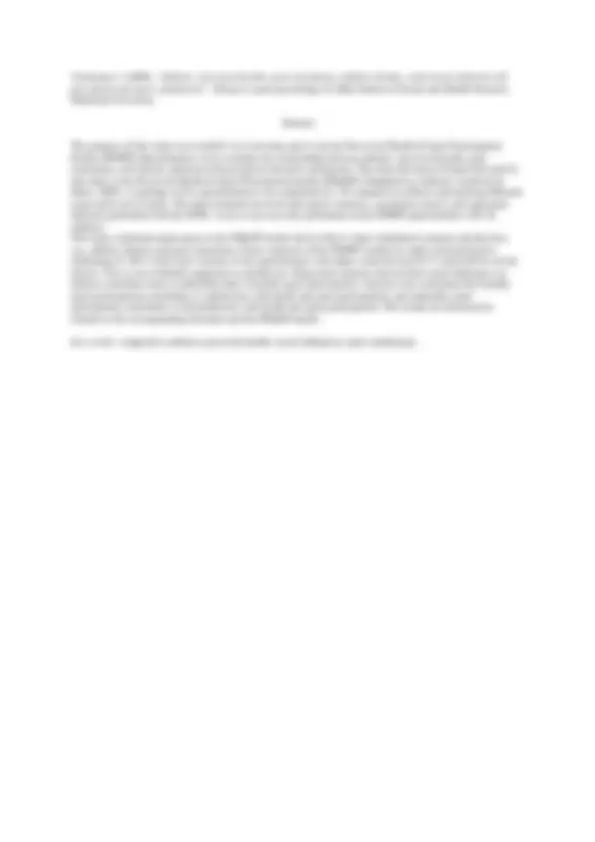
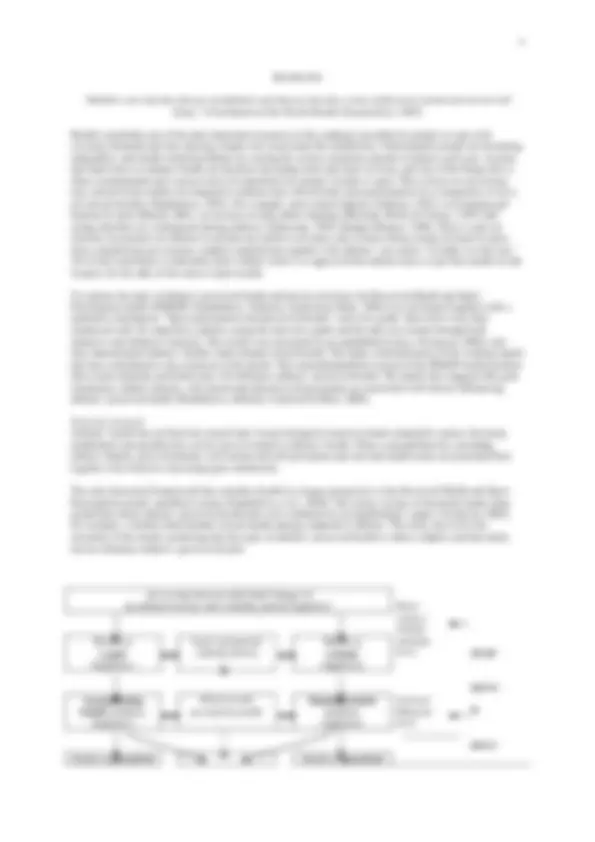
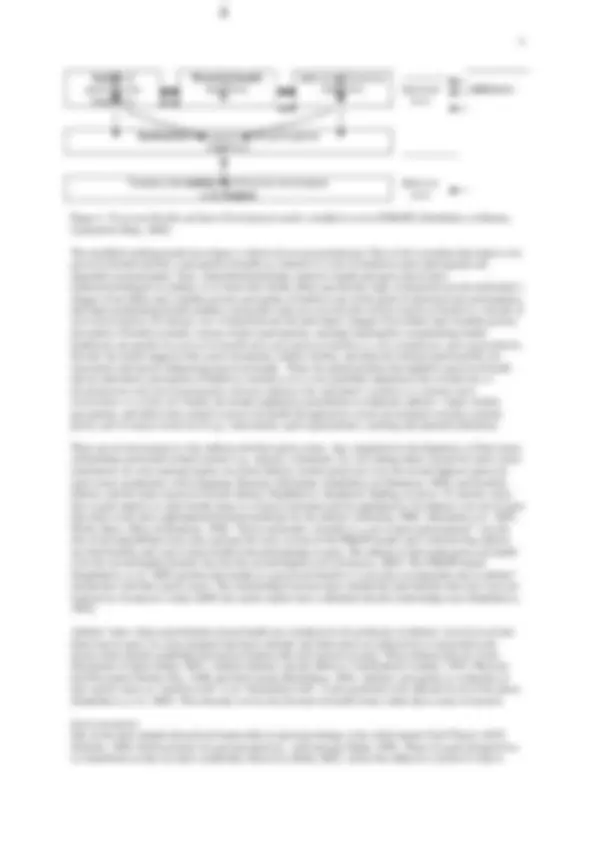




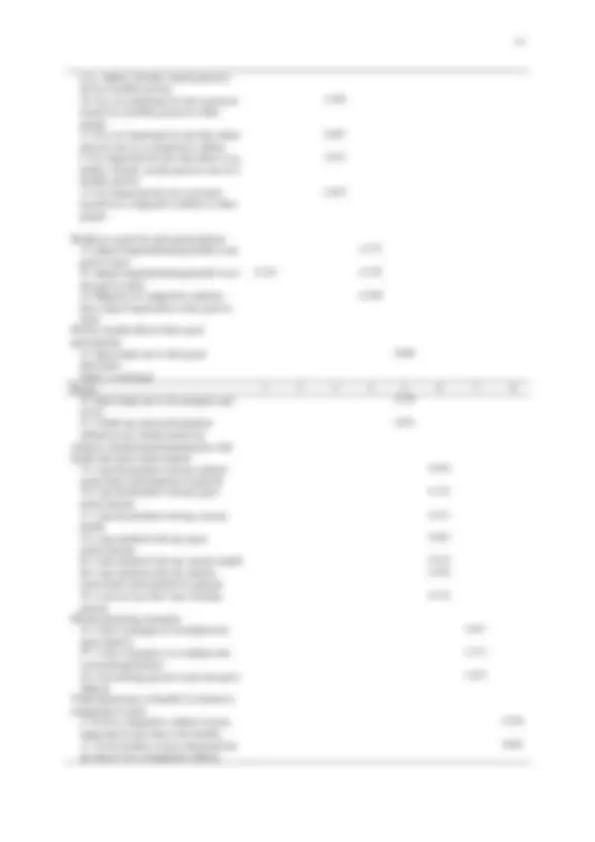
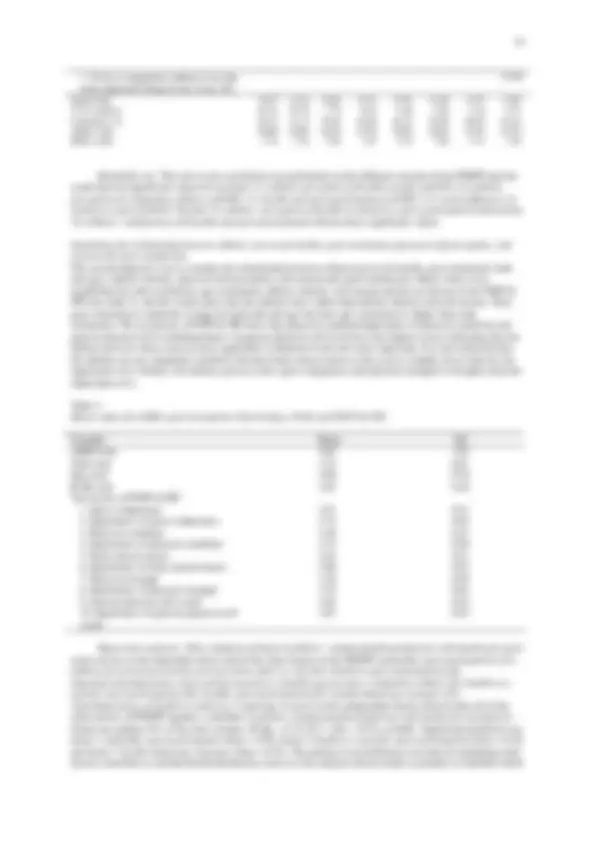



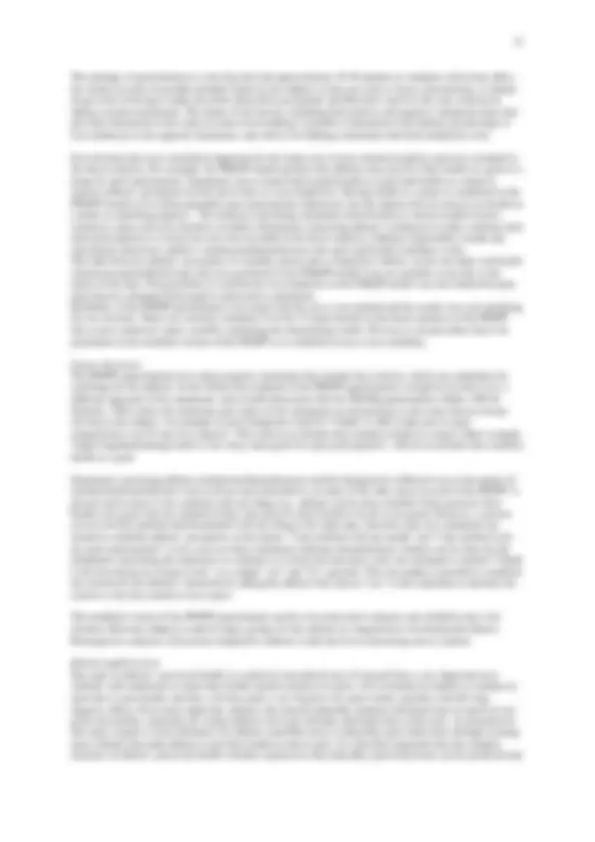






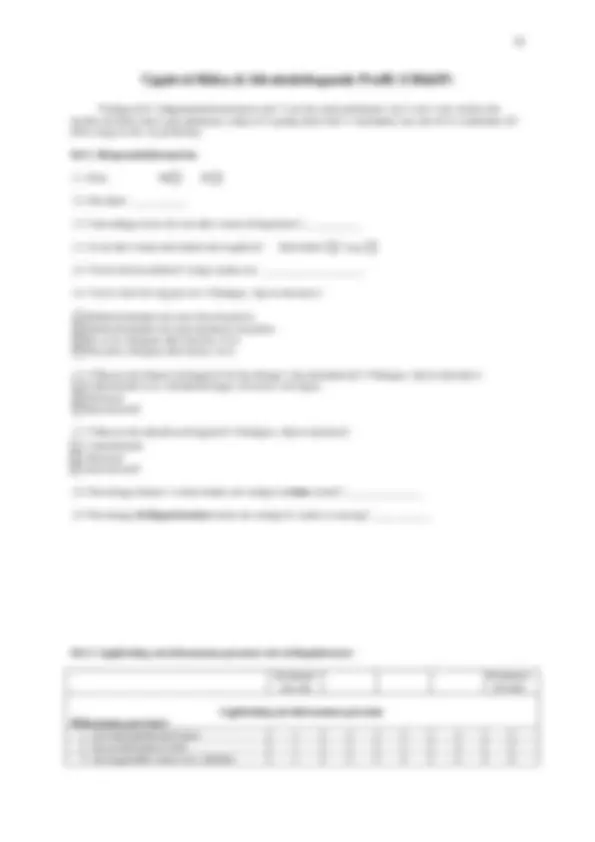
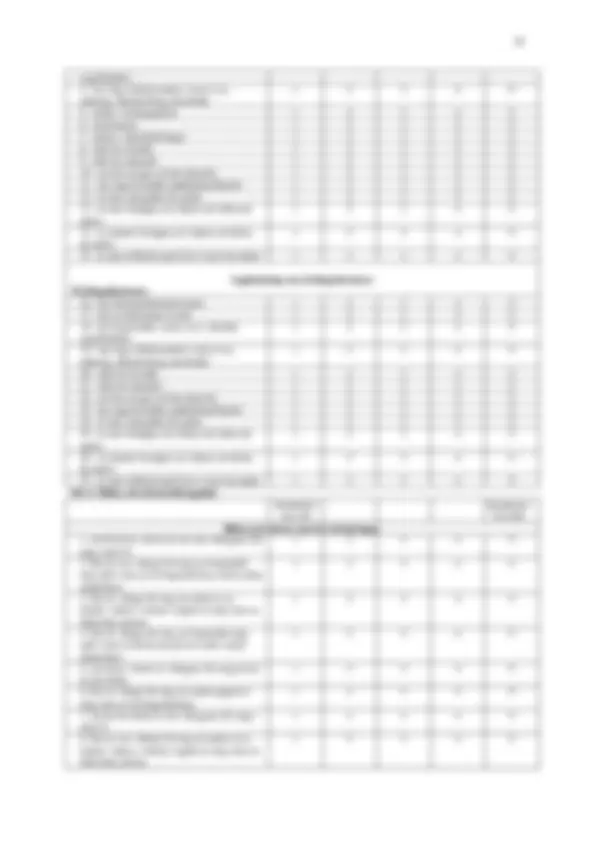
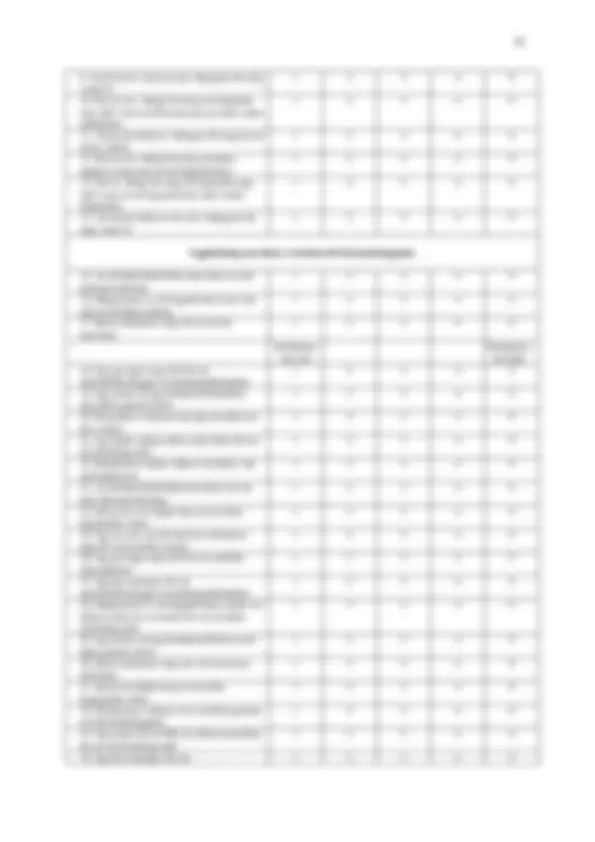
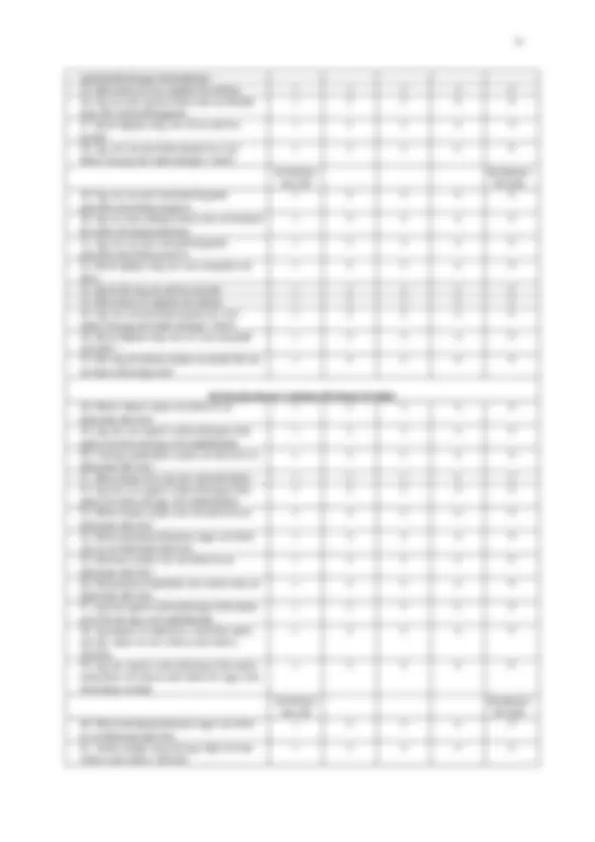
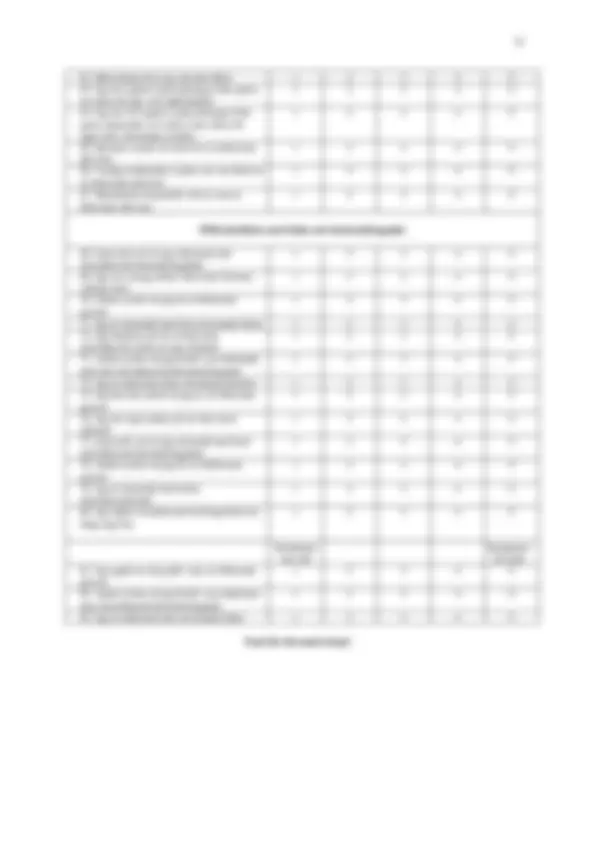
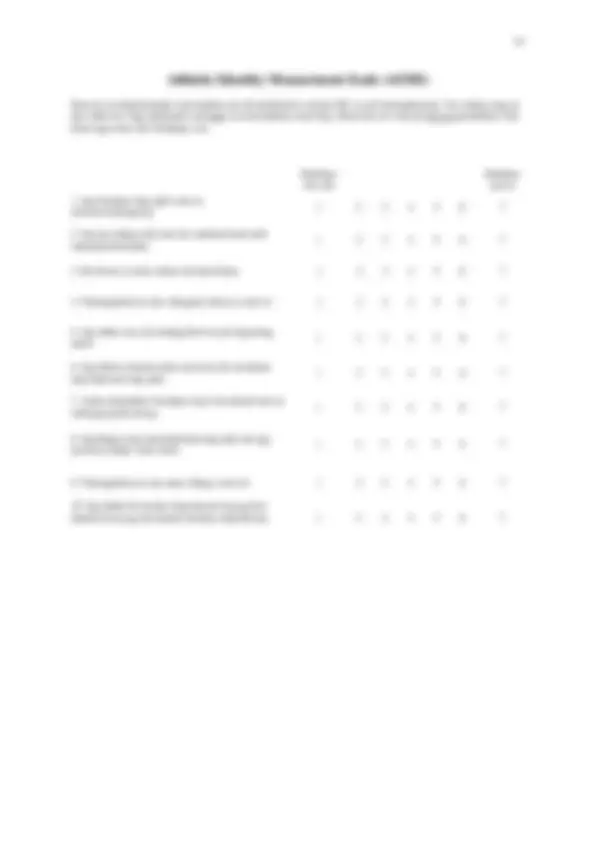
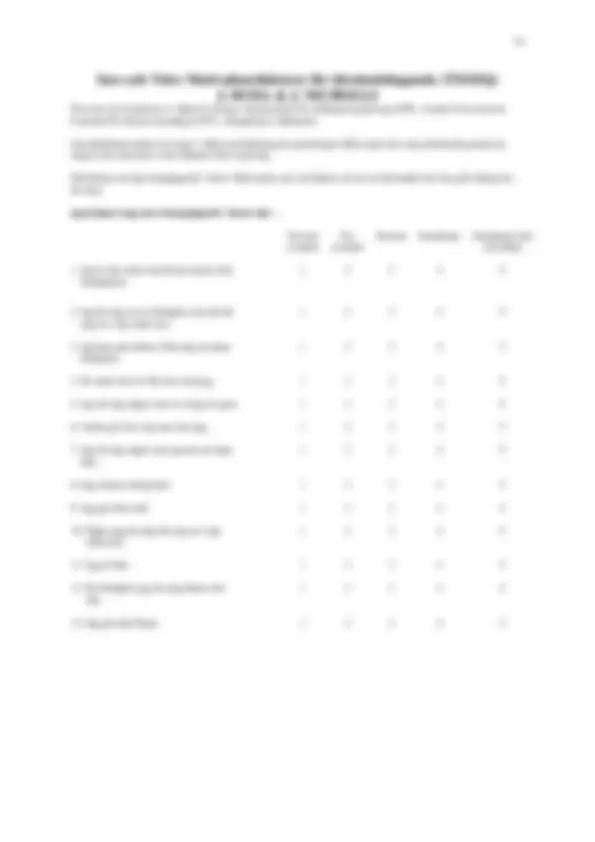
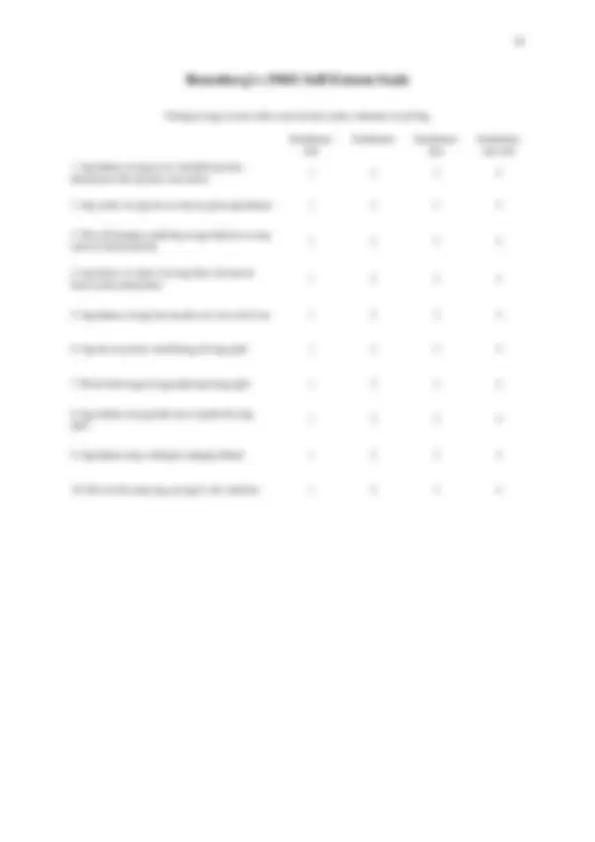

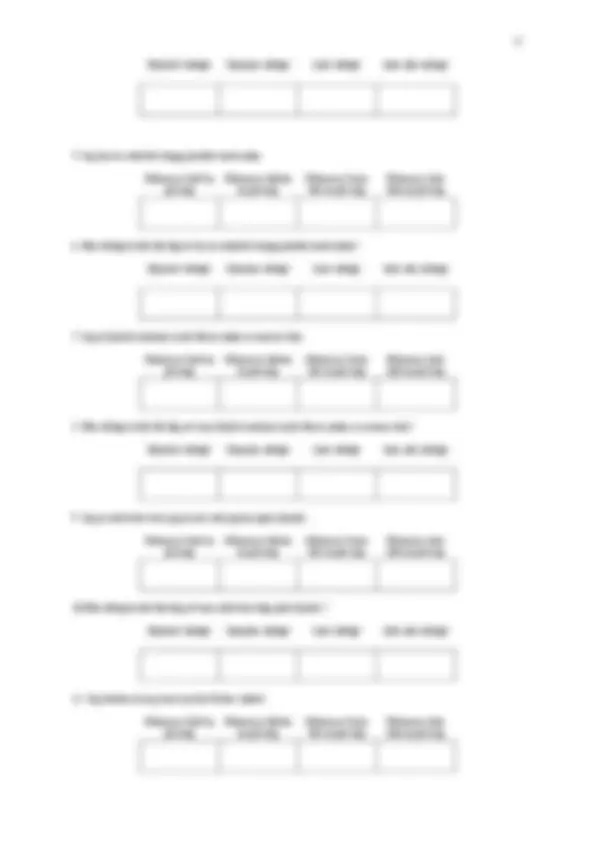
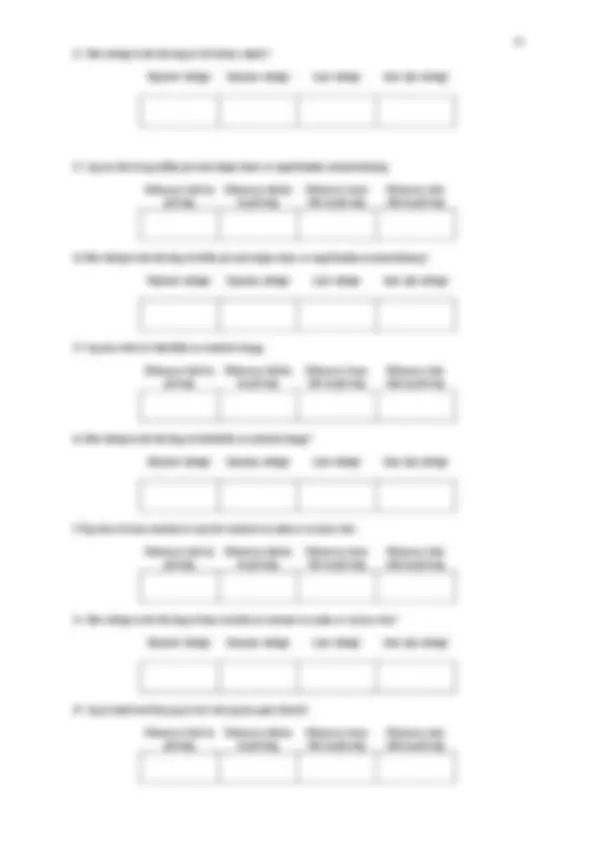
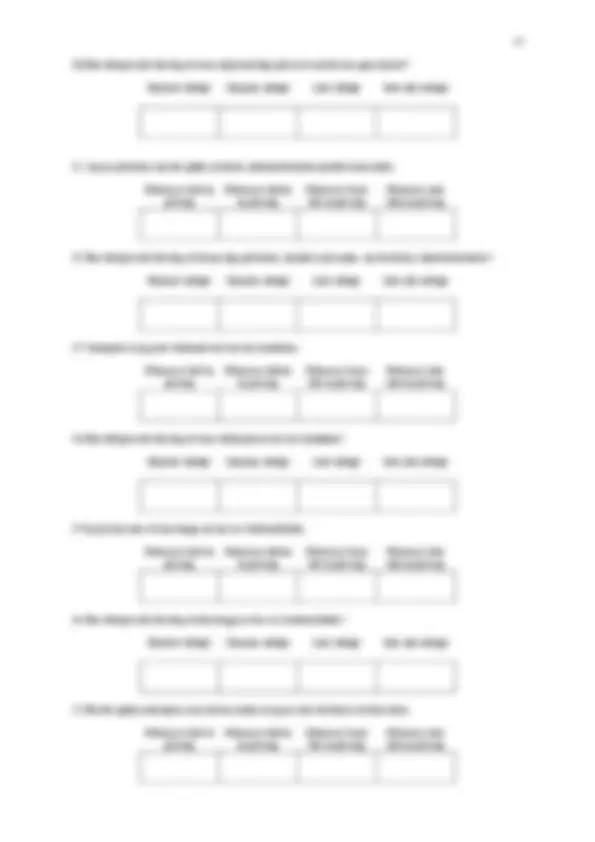
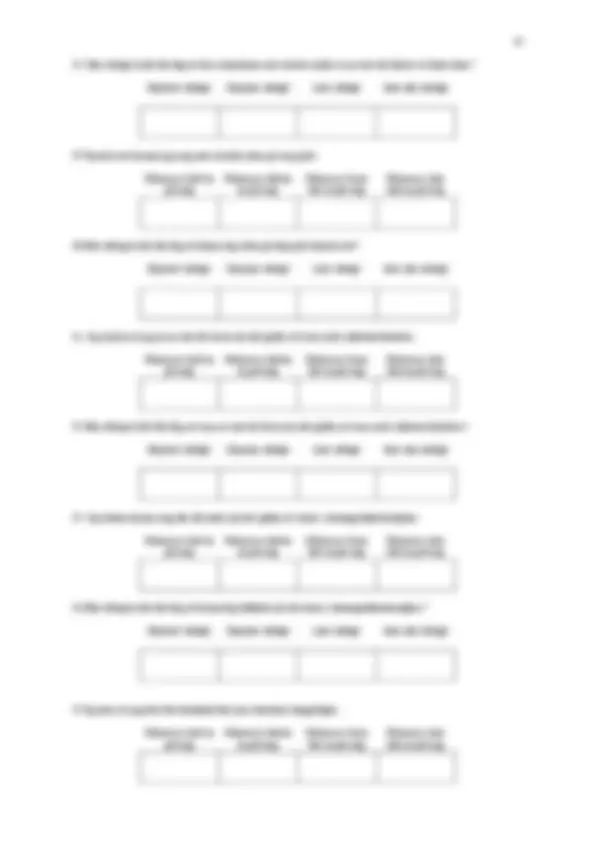
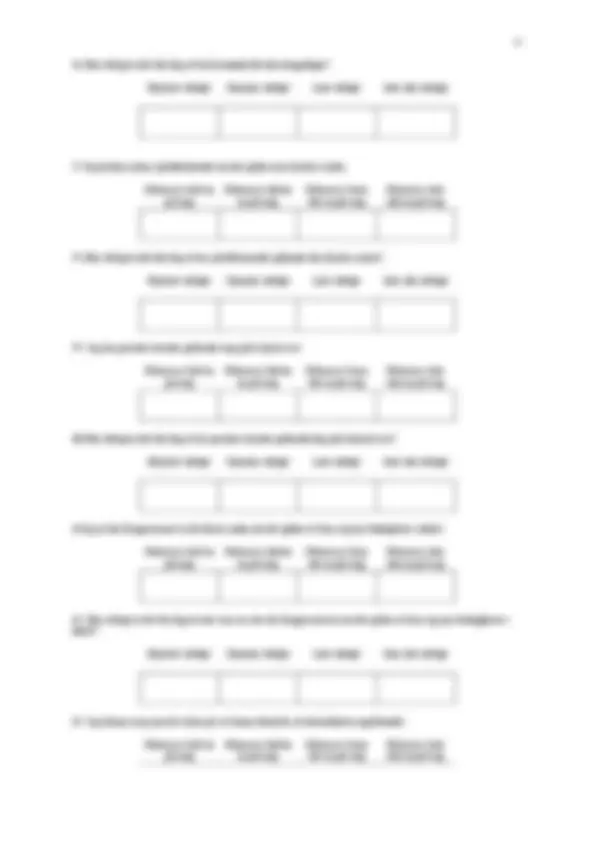
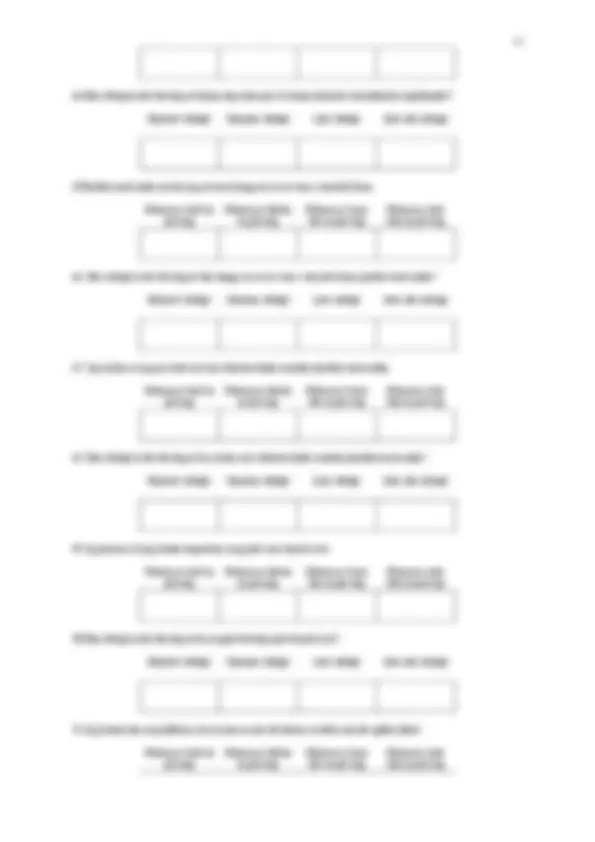
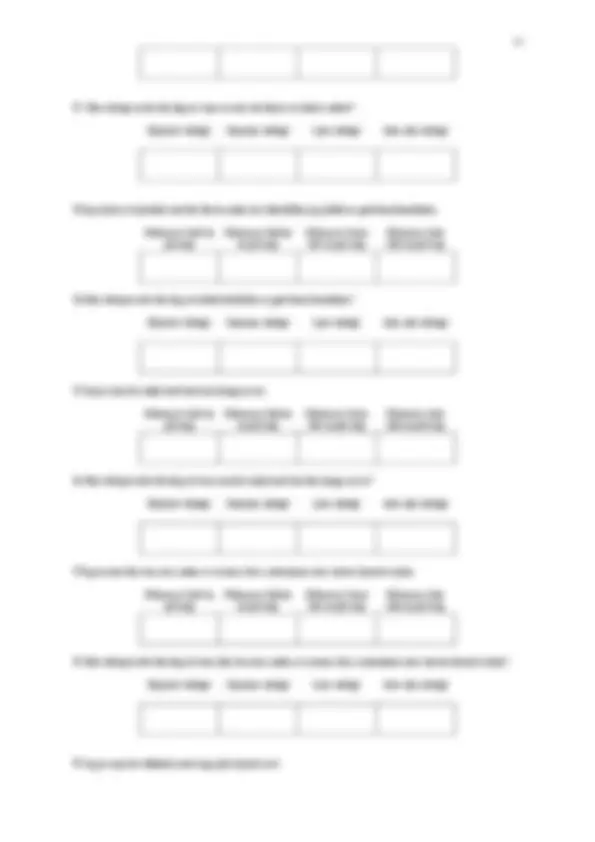

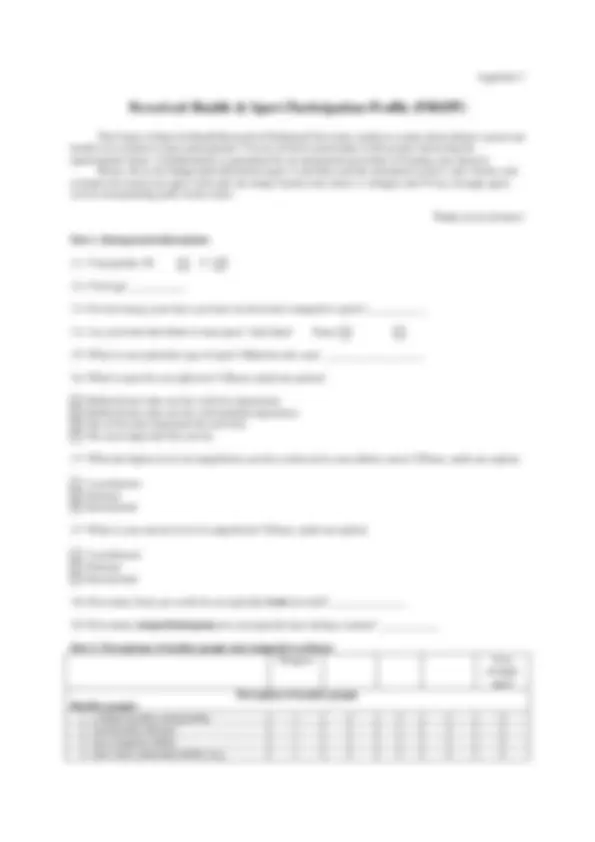
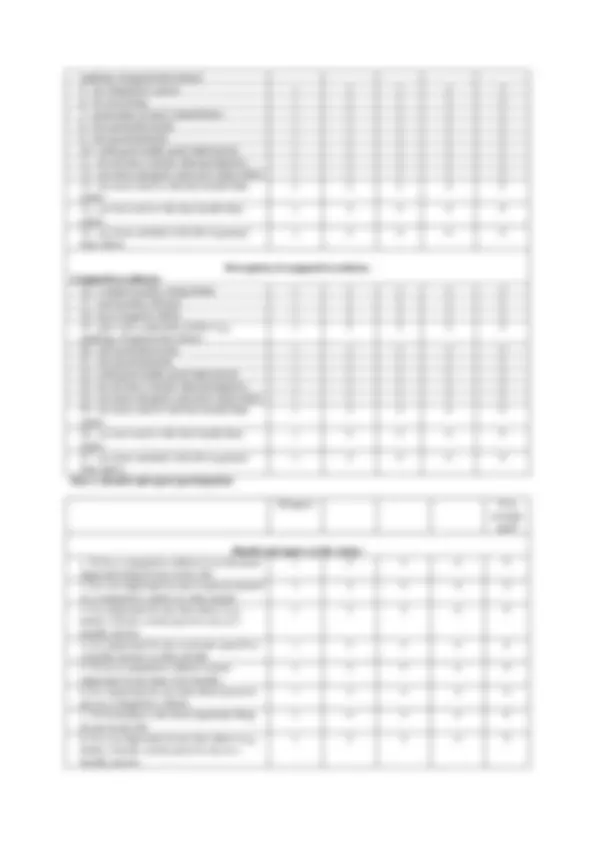
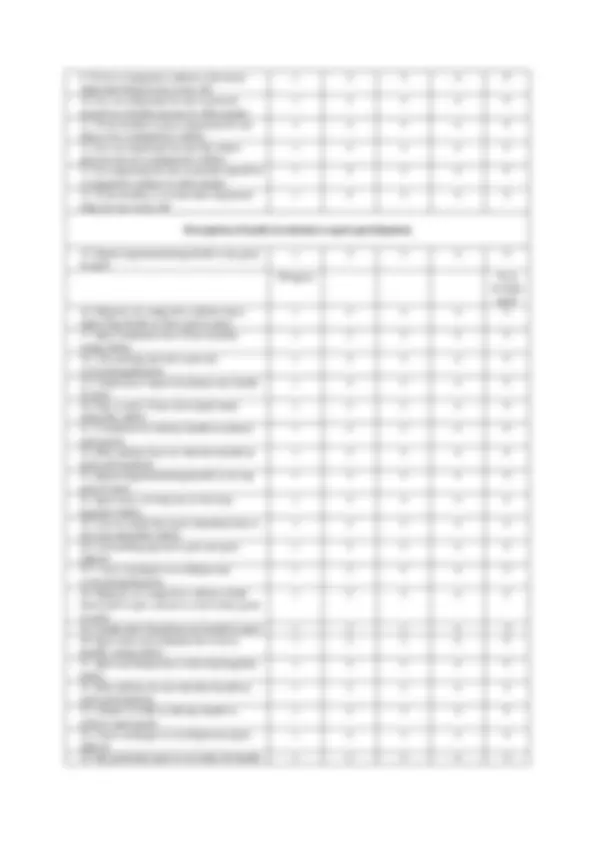
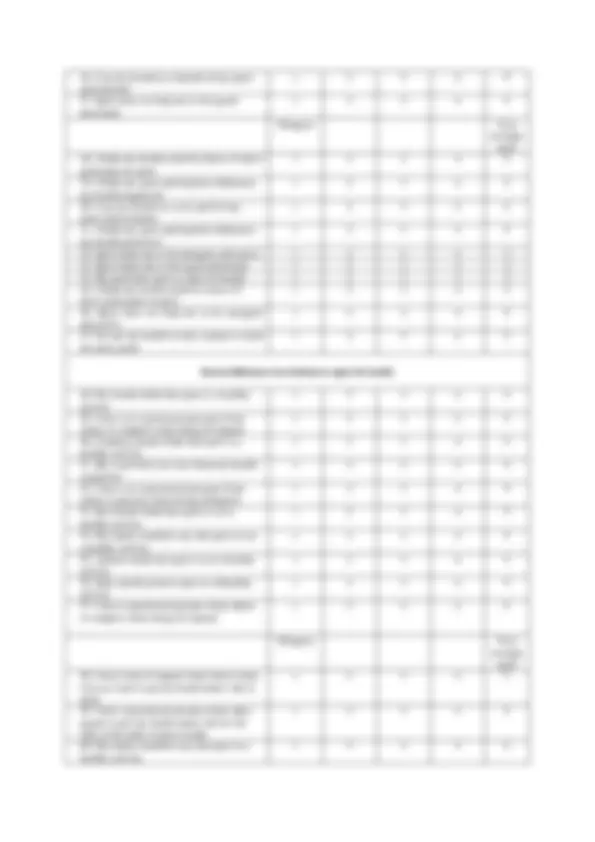
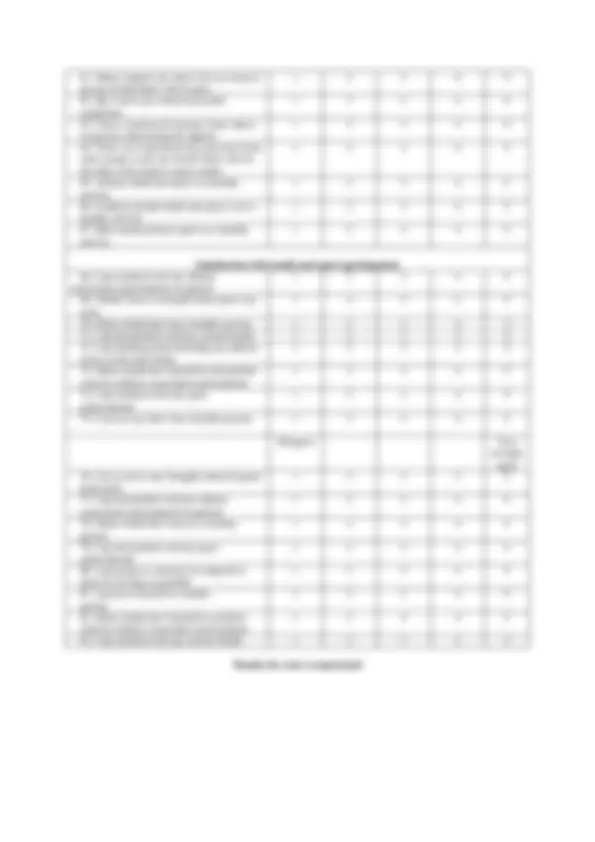
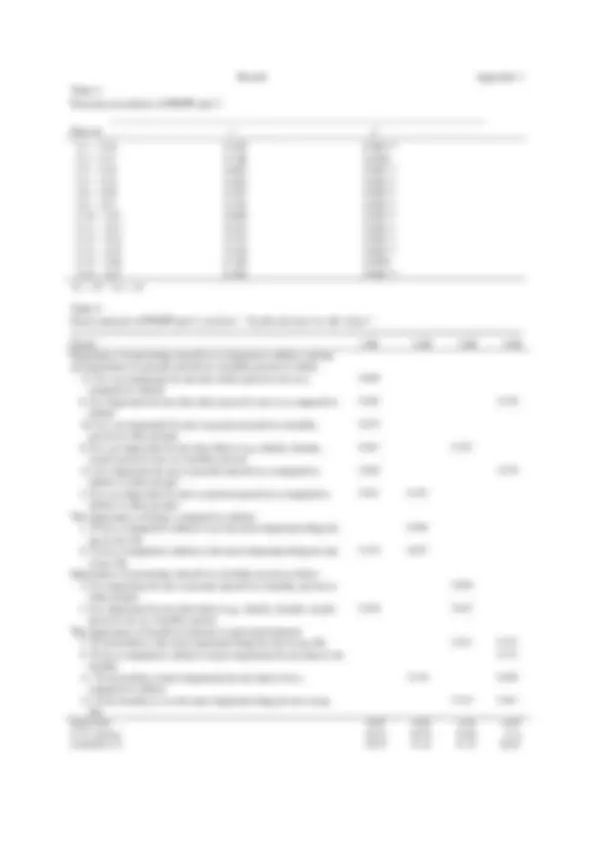

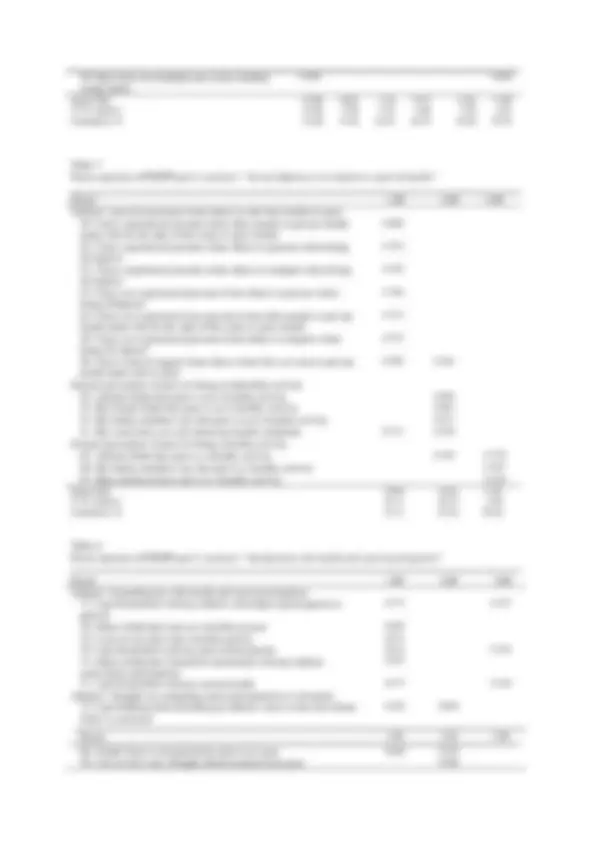

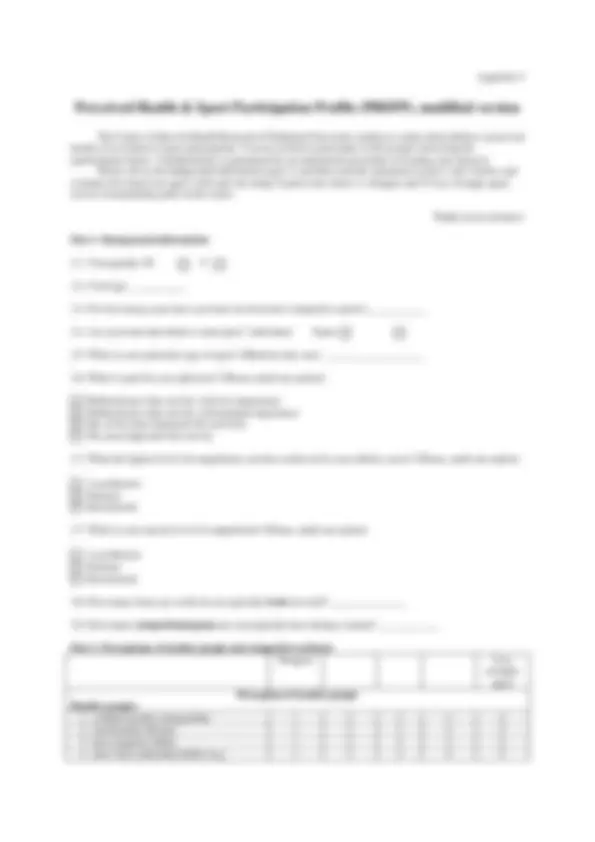
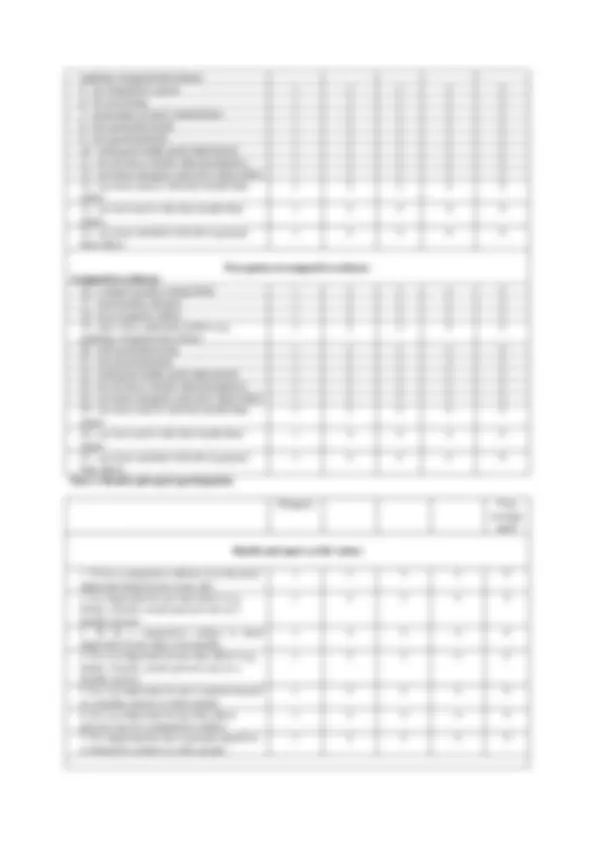
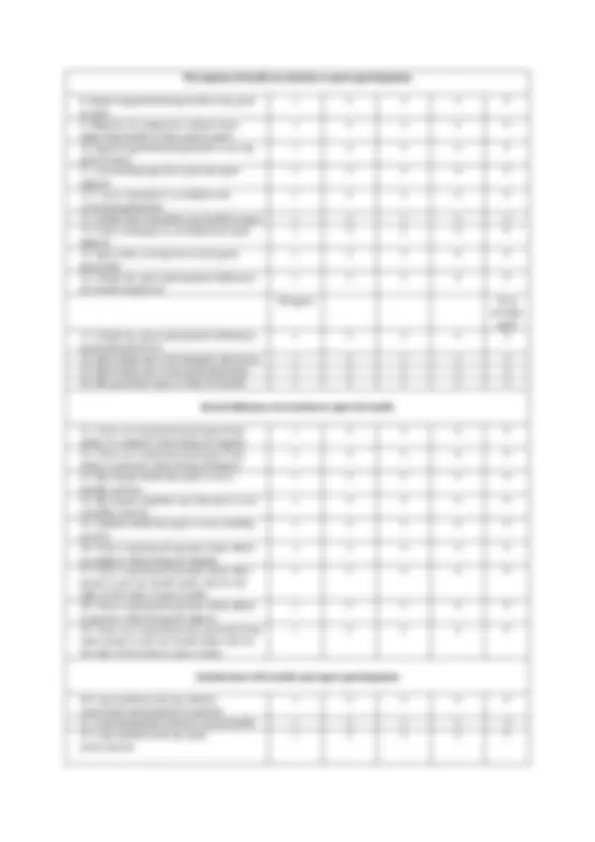



Study with the several resources on Docsity

Earn points by helping other students or get them with a premium plan


Prepare for your exams
Study with the several resources on Docsity

Earn points to download
Earn points by helping other students or get them with a premium plan
Community
Ask the community for help and clear up your study doubts
Discover the best universities in your country according to Docsity users
Free resources
Download our free guides on studying techniques, anxiety management strategies, and thesis advice from Docsity tutors
The Perceived Health and Sport Participation model (PH&SP) is a framework that explores the relationship between athletes' perceived health, basic values, and sport participation. The model predicts that athletes' perceived health and satisfaction with sport participation are influenced by their values, tendencies, and objective characteristics of their sports career. an overview of the PH&SP model, its development, and the findings from related studies.
Typology: Assignments
1 / 57

This page cannot be seen from the preview
Don't miss anything!


















































Alvmyren, I. (2006). “ Athletes’ perceived health, goal orientation, athletic identity, self-esteem, physical self perception and sport satisfaction”. (Uppsats i psykologi, inriktning idrott 61-80p.) Sektionen för Hälsa och Samhälle. Högskolan i Halmstad.
Sammanfattning
Syftena med denna studie var: (a) att utveckla och testa Upplevd Hälsa & Idrottsdeltagande Profil (UHIP) formuläret; (b) att undersöka relationen mellan idrottares upplevda hälsa, mål-orientering, idrottsidentitet, självkänsla, fysisk självuppfattning och tillfredställelse med idrottsdeltagandet. Som teoretiskt ramverk för denna studie användes Upplevd Hälsa & Idrottsdeltagande modellen (PH&SP) (Stambulova, Johnson, Lindwall & Hinic, 2005). Ett kompendium med fem frågeformulär besvarades av 139 tävlingsaktiva idrottare, inom olika idrotter och på olika nivåer. Bearbetningen av data gjordes i SPSS och inkluderade beskrivande statistik, korrelationer samt faktor- och regressions-analyser. Ett test-re-test genomfördes också med 30 av deltagarna. Studien bekräftade större delar av PH&SP-modellen och dess länkar till redan etablerade koncept och teorier, t.ex. idrottsidentitet och mål-orientering. Faktoranalyser av UHIP resulterade i åtta extraherade faktorer som kan förklara 61.64% av den totala variansen av frågeformuläret, och med alfa värden mellan 0.71 och 0.89 för alla faktorerna. Test-re-test reliabiliteten visade sig vara tillfredsställande. Regressionsanalyser visade att sociala influenser bidrog mer till ett ohälsosamt än ett hälsosamt idrottsdeltagande. Analyser bekräftade också att ett ohälsosamt idrottsdeltagande bidrar till otillfredsställelse med hälsan och idrottsdeltagandet, och ett hälsosamt idrottsdeltagande bidrar till tillfredställelse med hälsan och idrottsdeltagandet. Resultaten diskuteras i relation till den relevanta litteraturen och arbetsmodellen: Upplevd Hälsa och Idrottsdeltagande.
Nyckelord: sociala influenser, idrottsdeltagande, tillfredställelse, tävlingsidrott, upplevd hälsa
Introduction
“Health is not only the absence of infirmity and disease but also a state of physical, mental and social well- being” (Constitution of the World Health Organisation, 2005)
Health is probably one of the most important resources in life, making it possible for people to cope with everyday demands and also playing a major role in personal life satisfaction. Unfortunately people are becoming unhealthier, and health-related problems are costing the society enormous amount of money each year. Actions and behaviours to enhance health are therefore becoming more and more in focus, and one of the things that is often recommended and is perceived to be beneficial for people’s health, is sport. This is however not always true, and previous studies on competitive athletes have showed that sport participation on a competitive level is not always healthy (Stambulova, 1994). For example, sport related injuries (Johnson, 1997), overtraining and burnout in sport (Kenttä, 2001), an increase in drug-abuse (doping) (Mottram, Reilly & Chester, 1997) and eating disorders are widespread among athletes (Andersson, 1996; Sundgot-Borgen, 1996). There is also an increase in pressures on athletes to present top results at all times, due to more money being invested in sport, more competitions per seasons, tougher competitions together with athletes’ own desire “to make it to the top”. All of this contributes to unhealthy sport climate where it is approved that athletes have to put their health at risk in sport, for the sake of the team or sport results.
To explore the topic of athletes’ perceived health and factors involved, the Perceived Health and Sport Participation model (PH&SP) (Stambulova, Johnson, Lindwall & Hinic, 2004) was developed together with a qualitative instrument, “Sport participation and perceived health”, interview guide. Interviews were then conducted with 36 competitive athletes, using the interview guide and the data was treated through both inductive and deductive analysis. The results were presented in an unpublished essay (Alvmyren, 2005), and they demonstrated athletes’ double-sided attitude toward health. The study confirmed parts of the working model and also contributed to the extension of the model. The extended/modified version of the PH&SP model predicts that certain attitudes and behaviours will influence athletes’ perceived health. The model also suggests that goal orientation, athletic identity, self-esteem and physical self-perception are associated with factors influencing athletes’ perceived health (Stambulova, Johnson, Lindwall & Hinic, 2005).
Previous research Athletes’ health has not been the central topic in psychological research around competitive sports, but many established concepts/theories can be seen as related to athletes’ health. These concepts/theories, including athletic identity, goal orientation, self-esteem and self-perception and relevant health issues are presented here together with research concerning sport satisfaction.
The only theoretical framework that considers health in a larger perspective is the Perceived Health and Sport Participation model, modified version (Stambulova, et al., 2005). The earlier version of the model made some predictions about athletes’ perceived health that were confirmed in an unpublished c-paper (Alvmyren, 2005), for example, a double-sided attitude toward health among competitive athletes. The essay also led to the extension of the model, predicting that the topic of athletes’ perceived health is rather complex and that many factors influence athletes’ perceived health.
An overlap between individual images of an athlete/exerciser and a healthy person (high/low)
Health as a goal (high/low)
Goal orientation/ athletic identity
Health as a mean (high/low)
Basic values/ beliefs/ attitudes level
Accumulating health tendency (high/low)
Physical self- perception profile
Draining health tendency (high/low)
Activity/ Behavior level
Health as perceived Health as perceived
Social
macro-
&
micro-
benefit of sport/exercise (high/low)
Perceived health (high/low)
cost of sport/exercise (high/low)
Satisfaction with sport/exercise participation (high/low)
Appraisal level
influences
Tendency to continue sport/exercise involvement or to dropout
Behavior level
Figure 1. Perceived Health and Sport Participation model, modified version (PH&SP) (Stambulova, Johnson, Lindwall & Hinic, 2005)
The modified working model (see figure 1) allows for several predictions. First of all, it predicts that high or low perceived health and also a perception of health as a benefit or a cost of multiyear sport participation are depended on participants’ basic values/beliefs/attitudes related to health and sport and on their tendencies/strategies to enhance or to drain their health. More specifically, high overlap between the individual’s images of an athlete and a healthy person, perception of health as one of the goals of sport/exercise participation, and high accumulating health tendency can predict high perceived health and perception of health as a benefit of sport participation. In contract, low overlap between the individual’s images of an athlete and a healthy person, perception of health as mainly a mean of sport participation, and high draining/low accumulating health tendencies can predict low perceived health and a perception of health as a cost of multiyear sport participation. Second, the model suggests that a goal orientation, athletic identity, and physical self-perception profile are associated with factors influencing perceived health. Third, the model predicts that high/low perceived health and an individual’s perception of health as a benefit or as a cost contribute immensely into satisfaction or dissatisfaction with sport participation and also influence the individual’s tendency to continue sport involvement or to drop out. Fourth, the model emphasizes possibilities to influence athletes’ values, beliefs, perceptions, and behaviours related to perceived health through micro-social environment (coaches, parents, peers), and via macro-social level (e.g., mass media, sport organizations, coaching and parental education).
There are several reasons to why athletes end their sports career. Age, stagnation in development, civilian career, relationships and health-related reasons (e.g., injuries, exhaustion, etc.) are among major reasons for sport career termination. In cross-national studies on retired athletes, health turned out to be the second highest reason for sport career termination with Lithuanian, Russian (Alfermann, Stambulova & Zemaityte, 2004) and Swedish athletes, and the main reason for French athletes (Stambulova, Stephan & Järphag, in press). To end the career due to sport injuries or other health issues is a forced retirement and an unplanned or involuntary exit out of sport that often create more adjustment/emotional problems for the athletes (Alferman, 2000; Alfermann et al., 2004; Webb, Nasco, Riley & Headrick, 1998). “Perceived health: a benefit or a cost of sport participation?” was the title of the unpublished essay that explored the early version of the PH&SP model, and it showed that athletes see both benefits and costs to their health from participating in sport. The athletes in that study perceived health to be the second highest benefit, but also the second highest cost (Alvmyren, 2005). The PH&SP model (Stambulova, et al., 2005) predicts that health as a perceived benefit or a cost play an important role in athletes’ satisfaction with their sports career. The relationships between sport satisfaction and benefits and costs were not explored in Alvmyren’s study (2005) but earlier studies have confirmed that this relationship exist (Stambulova, 1994).
Athletes’ basic values and attitudes toward health are considered to be predictors of athletes’ activity level and behaviour in sport. It is also assumed that these attitudes and behaviours are affected by or associated with factors from already established theoretical frameworks and research in sport. These frameworks are: Goal Orientation in Sport (Duda, 2001), Athletic Identity concept (Brewer, Van Raalte & Lindner, 1993), Physical Self-Perception Profile (Fox, 1998) and Self-esteem (Rosenberg, 1965). Athletes’ perception or evaluation of their sports career as “satisfied with” or as “dissatisfied with”, is also predicted to be affected by all of the above (Stambulova, et al., 2005). This literature review has focused on health issues within these areas of research.
Goal orientation One of the most popular theoretical frameworks in sport psychology is the Achievement Goal Theory (AGT, Nicholls, 1989) which presents two goal perspectives - task and ego (Duda, 1989). These two goal perspectives, or orientations as they are more commonly referred to (Duda, 2001), reflect the subjective criteria to what is
The most commonly used theoretical framework is the Athletic Identity concept, AIC (Brewer, Van Raalte & Lindner, 1993). Athletic identity can be described as the degree to which an individual identifies to the athlete role. A person makes judgements of self worth and competence in different specific domains (e.g., athletic domain, academic domain). Depending on how important the person perceive a domain to be it will play an important role in how the person will feel about him-/her-selves and how he/she is affected by the outcome in that domain. For example, a person with strong athletic identity is especially “open” to self-perception in the athletic domain, and perceives involvement in sport as highly important. The athletic identity can also be seen as a social role or a self-labelling and may then be strongly influenced by others (e.g., family, media, friends, etc.) (Brewer, et al., 1993).
Identity is developed in different stages in life and young athletes who are highly involved in high-level competitive sport through important stages in their personal development, for example adolescent years, may develop a self-identity that is strongly connected to their sport and often entirely based on their athletic performance (Wylleman, 2002). If the athlete at this stage does not explore other careers, education and lifestyle options it can lead to a premature “identity foreclosure” making the athlete base their identity on sport alone. This strong connection to sport can lead to negative consequences for the athlete when he/she moves through different stages in their sports career (Wylleman, 2002), or when they decide to terminate their sports career (Pearsons & Petitpas, 1990; Wylleman, 2002). Recent studies support these findings and the results presented in these studies showed that a high athletic identity, contributed to more problems in the adaptation process after the sports career end (Alfermann, et al., 2004; Cecic Erpic, Wylleman & Zupancic, 2004). However having a high athletic identity is also consistent with pursuing a career in sport (Bussmann & Alfermann, 1994), and athletes can benefit from having strong emotional connections to their sport in terms of positive effects on athletic performance and a potential long-term involvement in physical activities (Phoenix, Faulkner & Sparkes, 2005). They can also benefit from having the total commitment which is required in high-level competitive sport in order to achieve optimal athletic performance (Danish, 1983). It is however important to allow the individual to explore other identity options to avoid negative consequences (Wylleman, 2002).
Adaptation problems through the sports career stages may also lead to a crisis for the athlete, and to a (premature) dropout from sport (Stambulova, 2003). A strong athletic identity may also leave the athletes more vulnerable to emotional coping difficulties when they are injured, as injury will stop or decrease their performance in sport. To the athlete this may mean taking away their only source of self-worth and self-identity, increasing the risk of not being able to cope emotionally (Pearsons & Petitpas, 1990). There is also an increased risk of being injured as the athlete that possesses a strong athletic identity is more likely to engage in sport to an extent where training and competing can have serious detrimental effects on his/her health (e.g., excessive training or competing/training while ill or injured) (Brewer, et al., 1993). The PH&SP model (Stambulova, et al.,
Physical self-perception & Self-esteem There are several theoretical models concerning the self-concept and the most commonly used model to present the self in sport settings is the Hierarchical model of self-concept (Shavelson, Hubner & Stanton, 1976). The hierarchical model was created from an academic viewpoint and the general self-concept (the highest level) is divided on the next level into an academic and a non-academic self-concepts. The non-academic self-concept consist of the social self, the emotional self and the most interesting in sport settings – the physical self, and each self has its own structure and content (Shavelson et al., 1976). Like athletic identity, the self is validated in the different domains in terms of how well the self is doing, and the more important or central the domain is to the individual the more self-esteem will be affected by his/her “performance” or presentation (Fox, 2000b). Global self-esteem is affected by all the different domains. The physical domain consists of physical appearance and physical competence and the different levels of them, namely domain, sub-domain, facet, sub-facet and situation-specific level. For example the physical domain level can be described as physical self-worth. The sub- domain divided into sport competence and attractiveness. Sport competence can, for example, at the facet level be soccer competence, in the sub-facet level it is shooting ability and at a situation-specific level scoring efficacy. Examples of the sub-domain attractiveness can be fatness at the facet level, fatness of hips at the sub- facet level and feeling fat hips in these clothes in the situation-specific level (Fox, 2000b). Global self-esteem is often measured using Rosenberg’s (1965) Self-Esteem Scale that refers to pride in self, general competence and
equal worth to others. The physical aspect of self is measured using the Physical Self-Perception Profile (Fox & Corbin, 1989), focusing on the individual’s perception of sport competence, physical strength, physical condition, body attractiveness and overall physical self-worth (Fox, 2000b).
The self is best described as a rather complex system of constructs. The self-concept is constructed of characteristics, competencies, attributes and roles possessed or played by the individual, and it is multidimensional (Fox, 2000a; 2000b). The physical self has a major role in the self-concept because the body presents abilities, appearances and attributes, and therefore is the main function in social communication. The body is used to express status and sexuality and is therefore a major part in own overall self-rating – the global self-esteem (Fox, 2000b). Self-esteem can also be defined as “the degree to which individuals feel good about themselves” or as a “personal judgement of worthiness” (Sonstroem & Morgan, 1989). Self-esteem is also considered to have strong connections to our well-being and quality of life. High self-esteem is often associated with healthy behaviour, for example, healthier eating habits and involvement in sport, whereas low self-esteem is connected to mental illness and absence of well-being (Fox, 1998, 2000a).
The PH&SP model (Stambulova et al. 2005) makes the prediction that athletes’ physical self-perception is associated with athletes’ tendencies to either accumulate or to drain their health related resources. The association is highly probable when considering how important it is to the human beings to always present the most favourable image of themselves (Leary & Kowalski, 1990). Human beings enjoy feeling good about themselves and avoid situations that will make them feel inadequate or bad about themselves. They constantly seek indicators of worth through social, intellectual, materialistic and professional situations, so much that they can risk their own health to gain this worth. For example, using drugs to increase performance (Fox, 1998), excessive training (Martin Ginis & Leary, 2004) and changing the information about themselves to present a more favourable picture for others (Fox, 1998). In Alvmyren’s study (2005) the majority of athletes risked their health from time to time in sport (e.g., competed while ill or injured) trying to impress coaches and team-mates (Bray, Martin & Widmeyer, 2000). In some sport-environments these health risk behaviours are also considered as personal toughness (Martin Ginis & Leary, 2004) and a way to gain respect of team-mates, opponents and coaches (Canadian Broadcasting Corporation, 2000). As mentioned earlier the more time and efforts that are invested in a domain the more individuals rely on the self-worth in this domain. To elite athletes who invest a major part of their life into the physical domain, self- esteem becomes based on the athletic performance (McPherson, 1980; Saint-Phard, Van Dorsten, Marx & York, 1999), creating an identity closely connected to sport (Brewer, Van Raalte & Linder, 1993).
Factors contributing to sport satisfaction There are no theoretical frameworks that have sport satisfaction as the main issue. However there is a model that considers sport satisfaction in relation to other factors of a sports career: the Synthetic Sports Career Model (Stambulova, 1994). The model predicts that four different objective characteristics will influence the subjective evaluation of athletes’ satisfaction with sports career, and the four objective characteristics of the Sports Career (SC) are: length (time of SC), generalization/specialization (number of sport events and roles in sports), level of achievement (results of SC) and costs (expenses of SC). The four objective characteristics are supplemented by two subjective characteristics: athlete’s satisfaction (own evaluation of SC) and level of success (results of SC evaluated by others). Together the objective and subjective characteristics make an overall synthetic description of the athletes’ SC. In the description of the model the “level of achievement” can also be interpreted as the “Benefits” of a sports career. These benefits can be seen from two different perspectives; the “narrow” which includes sport qualifications, titles, ranks, records and results in competition, and the “broader”, which is more about the athletes’ development, for example, achieved sport and life experiences, personal characteristics that can be reflected in other spheres of life, social status and a financial well being due to sports. If the level of achievement is interpreted as “benefits”, the “costs” are the expenses, or the price the athlete has to pay for the sports career, for example time, energy, health, money, losses in other spheres of life.
Performance outcome is a factor that contributes to athletes’ satisfaction with sport participation and it is easily thought that achieving excellence in sport and meeting set goals should be the key to sport satisfaction but previous research has shown that satisfaction is a far more complex matter and it is influenced by many other factors than just performance outcome (Stambulova, 1995). Stambulova’s study (1995) presents 6 different types of satisfied athletes and 9 types of dissatisfied athletes in Russian sample. The 6 satisfaction types are as follows.
(g) Some PSPP & PIP factors (e.g., physical condition) contributes to healthy sport participation, and some PSPP & PIP factors (e.g., body attractiveness) contributes to unhealthy sport participation
Method
Participants The participant were 139 competitive athletes, 82 males and 57 females (M age = 22.2 years; SD = 5.8). The athletes represent both individual sports (n = 53): orienteering, tae-kwon-do, long distance running, orienteering biathlon, badminton, canoeing, fencing, swimming, golf, kick-boxing, kung-fu, tennis and equestrian sport, as well as team-sport (n = 86): handball, floorball, volleyball, ice-hockey and soccer. Their levels of competition include three categories: local/district (n = 62), national (n = 47) and international (n = 28). The selection criteria for the athletes were that they had to, on a regular basis, take part in competitions on a local/district, national or international level and be of the age between 17 and 44.
Instruments A package of five instruments was used in this study (see appendix 1). The Perceived Health & Sport Participation Profile (PHSPP) is a new and never tested instrument. The PHSPP was developed to make a better understanding of athletes’ perception of health in relation to their sport participation. The PH&SP model (modified version) (Stambulova, et. al., 2005) formed the structure of the questionnaire. Questions/statements were constructed using this model and the data from qualitative interviews with competitive athletes (Alvmyren, 2005). For example, in the interviews the athletes had to give their description of a healthy person, and the results concluded in statements like “a person with healthy eating habits” and “someone who exercise”. In the interviews the athletes also expressed their life values, reasons for participating in competitive sport, sport and life goals, strategies to enhance health and prevent injuries, their experiences in injury rehabilitation and overtraining/burnout, their perceived “benefits” and “costs” of sport participation. From the raw data of these interviews, 110 statements were developed and grouped together to match/test the different levels and sections of the PH&SP model. There is also a minimum of four similar statements to each variable to ensure reliability, by making sure that the different options of the statements are covered. Subjects are supposed to express how much they agree/disagree to each statement, on a 5-point Likert scale where 1 = disagree and 5 = very strongly agree. The basic version of the PHSPP was created in English
triangulation procedures with two experts to ensure the quality of the translation. A pilot-test was conducted on the PHSPP with three athletes, to ensure that the statements were easy to understand, and the pilot-test resulted only in minor changes. A test-re-test was also performed on the PHSPP by 30 participants with 2-3 weeks between the first and second time they answered the questionnaire, to ensure the reliability of the instrument. The basic version of the PHSPP tested in this study consists of three parts. The first part is general background information, for example, age, gender, sport, level of competition etc. Part two concerns the athletes’ perception of healthy people and their perception of competitive athletes in two sections. The first section consists of statements about healthy people, for example, “Healthy people have healthy eating habits”, and the second section have matching statements about competitive athletes, for example, “Athletes have healthy eating habits”. The third part of the questionnaire provides statements on the topic of health and sport participation and it is divided into four sections. Section one represents “ health and sport as life values” , with statements like “To be healthy is the most important thing for me in my life” and “It is not important for me that others perceive me as a competitive athlete”. Section two represents “perception of health in relation to sport participation ”, and contains statements like “I think that I drain/lose my health in sport” and “Sport helps me to feel good physically”. The third section represents “social influences in relation to sport & health” , for example, “Mass media pictures sport as a healthy activity” and “I have not experienced pressure from others to practice when being ill/injured”. Section four represents athletes’ “satisfaction with health and sport participation ”, for example, “I perceive myself as a healthy person“ and “I am satisfied with my sport achievements”. The PHSPP, English basic version is presented in appendix 2. The Athletic Identity Measurement Scale (AIMS) (Brewer, Van Raalte & Lindner, 1993) is a 7-point Likert scale test where 1 = do not agree at all and 7 = agree precisely. The questionnaire consists of 10 statements that concerns athletes’ perception of their identity in relation to sport, for example, “Training/sport is the most important part of my life”. The Task and Ego orientation in Sport Questionnaire (TEOSQ) (Duda, 1989 & Nicholls, 1984) is a 5- point Likert scale test where 1 = totally disagree, 2 = disagree, 3 = neutral, 4 = agree and 5 = totally agree. The questionnaire consists of 13 statements concerning athletes’ perception of personal success in sport settings. For example, “I feel most successful in sport when I am the best” and “I feel the most successful in sport when I learn something new by working hard”.
Rosenberg’s Self-Esteem Scale (RS-E) (Rosenberg, 1965) is a 4-point Likert scale test where 1 = totally agree, 2 = agree, 3 = don’t agree and 4 = don’t agree at all. The scale was reversed before the data-analyses. The questionnaire consists of 10 statements that measure subjects’ level of self-esteem, for example, “I feel I have a lot to be proud of”. In all of the questionnaires above, subjects are supposed to express their agreement/disagreement with each statement in the questionnaire. The Physical Self-Perception Profile (PSPP) and Perceived Importance Profile (PIP) (Fox & Corbin, 1989). The PSPP is a 30-item self-report questionnaire consisting of five sub-domains with six items each. The sub-domains are: (1) perceived sport competence (sport); (2) physical conditioning (condition); (3) bodily attractiveness (body); (4) physical strength (strength), and (5) physical self-worth. Two alternative statements describing people are presented, from which the individuals can choose which one best represent themselves, using “sort of true” to “really true”. Each item is then scored from 1 to 4. The PIP is incorporated into the PSPP questionnaire and focuses on the importance that people attach to four of the five PSPP sub-domains (sport, condition, body and strength) (Lindwall (2004).
Procedure Subjects were selected based on availability and meeting the criteria. A total of 157 test-packages were distributed and 18 were removed before treatment of the data, due to not being completed properly. To ensure having a variety of sports, ages and levels of competition involved contacts were made with students at Halmstad University; high-school students who have sports as a part of their schedule (contact was made through their physical education teacher); staff and cadets at the military school (contact was established through their physical education instructor); friends who are competitive athletes and could distribute the questionnaire to team-members, friends and workmates; the local handball club; the local orienteering club and also with members of the Swedish national team in orienteering. The test-packages were distributed to the subjects in several different ways: by the author in person; via post and e-mail (the subjects then printed the test-package and returned it by post); via assistants who were informed about the criteria for the study, and also had brief information of the study and the ethical aspects (e.g. physical education teachers and instructors). Subjects were given instructions regarding the test, short information about the aim of the study and their guaranteed confidentiality by the anonymous treatment of the data. They were also informed that their participation in the study was voluntary and that they could withdraw from the study at any time. The subjects who were part of the test-re-test group were informed of the aim of the re-testing.
Analyses All of the data was analysed in SPSS 13.0, according to the two objectives of this study. The first objective was to test and evaluate the PHSPP questionnaire. Part 2 of the PHSPP questionnaire presents the athletes’ perception of a healthy person (items 2:1 to 2:15) and their perception of a competitive athlete (items 2:16 to 2:27) and were computed into two new variables: athletes’ perception of a healthy person and athletes’ perception of competitive athletes. These two variables consist of matching statements and each pair of matching statements were analysed using Pearsons test of correlation. Three items that belonged to athletes’ perception of a healthy person were excluded from the correlation as they had no matching statements in the other variable. These items represent athletes’ perception of healthy people as people who: - do competitive sport (2:5); - do exercise (2:6); – participate in sport competitions (2:7). Mean values were calculated for these three items in three groups of athletes according to their different levels of competition.
Part 3 of the PHSPP was analysed in two steps. In step one separate factor analyses were performed on the four sections of Part 3, and the data was analysed using maximum likelihood estimation and varimax rotation (see tables 4-8, appendix 3). The internal consistency was also checked by extracting alpha values for each factor (see table 9, appendix 3). Due to unsatisfying values of the total variance (less than 60%) for most of the sections, a new analysis was performed on the entire part 3. The data was analysed using maximum likelihood and an oblimin rotation. Items with poor statistical significant values were deleted in the process and the analyses resulted in 8 extracted factors, explaining 61.5% of the total variance. Reliability was also checked for each factor and mean values were calculated.
The second objective of the study was to examine the relationship between athletes’ perceived health, goal orientation, athletic identity, physical self perception, self-esteem and sport satisfaction. Mean values were calculated for AIMS total, goal orientation (Task total and Ego total), RS-E total and for each of the 10 factors in PSPP/PIP.
Based on the PH&SP-model and the corresponding hypotheses, several multiple regression analyses were conducted with 8 PHSPP factors, AIMS, Task and Ego orientation, RS-E and 10 factors of PSPP & PIP.
Factor 3 contains five items that describe the importance/unimportance of presenting oneself as a healthy person and a competitive athlete. Examples of items are “It is not important for me that others (e.g., family, friends, coach) perceive me as a healthy person” and “It is important for me to present myself as a competitive athlete to other people”. Factor 4 contains three items describing health as a goal for sport participation. Examples of items are “Improving/maintaining health is my goal in sport” and “Majority of competitive athletes have improving health as their goal in sport”. Factor 5 contains three items that describe positive health effects from sport participation. Examples of items are “Sport helps me to feel good physically” and “I think my sport participation influences my health positively”. Factor 6 contains seven items that describe athletes’ satisfaction/dissatisfaction with health and sport achievements. Examples of items are “I am dissatisfied with my sport achievements” and “I am satisfied with my current health”. Factor 7 contains three items describing health enhancing strategies. Examples of items are “I have strategies to avoid/prevent sport injuries” and “I do nothing special to prevent sport injuries”. Factor 8 contains three items that describe value/importance of health in relation to competing in sport. Examples of items are “To be a competitive athlete is more important for me than to be healthy” and “To be healthy is more important for me than to be a competitive athlete”. The complete list of factors and items is presented in table 2 and the modified version of the PHSPP is presented in Appendix 4.
Table 2 Factor analysis PHSPP, part 3
Factor 1 2 3 4 5 6 7 8 Unhealthy sport participation
Athletes think that sport is not a healthy activity
My friends think that sport is not a healthy activity
Table 2 continued Factor 1 2 3 4 5 6 7 8
I think my sport participation influences my health negatively
Sport does not help me to feel good physically
My family members say that sport is not a healthy activity
I think that I drain/lose my health in sport
Athletes’ perceived pressure/no pressure from others to risk their health in sport
-0.
-0.
-0.
-0.
-0.
-0.
The importance/unimportance of presenting oneself as a healthy person and a competitive athlete
(e.g., family, friends, coach) perceive me as a healthy person
It is not important for me to present myself as a healthy person to other people
It is not important for me that others perceive me as a competitive athlete
It is important for me that others (e.g., family, friends, coach) perceive me as a healthy person
It is important for me to present myself as a competitive athlete to other people
Health as a goal for sport participation
-0.
0.329 -0.
-0.
Positive health effects from sport participation
Sport helps me to feel good physically
Table 2 continued Factor 1 2 3 4 5 6 7 8
Sport helps me to be energetic and active
I think my sport participation influences my health positively
Athletes satisfaction/dissatisfaction with health and sport achievements
I am dissatisfied with my athletic career/sport participation in general
I am dissatisfied with my sport achievements
I am dissatisfied with my current health
I am satisfied with my sport achievements
I am satisfied with my current health 0.
I am satisfied with my athletic career/sport participation in general
I can not say that I am a healthy person
Health enhancing strategies
I have strategies to avoid/prevent sport injuries
I have strategies to avoid/prevent overtraining/burnout
I do nothing special to prevent sport injuries
Value/importance of health in relation to competing in sport
To be a competitive athlete is more important for me than to be healthy
To be healthy is more important for me than to be a competitive athlete
factors contribute to satisfaction and which factors contribute to dissatisfaction because factor 6 contains statements of both. In order to do so factor 6 was divided into two new variables containing items that represent: athletes’ satisfaction with health and sport and athletes dissatisfaction with health and sport. Two new separate regression analyses were performed, R1b and R1c, with the same independent factors as in R1a but with the two new variables as dependent factors.
(R1b) The analysis with athletes’ satisfaction with health and sport showed that all of the factors of the PHSPP contribute to satisfaction and can explain 17% of the total variance, R^2 adj. = 0.17, F(7, 128) = 4.81, p<0.001. Significant predictors were factor 4 health as a goal for sport participation (beta = 0.24 and factor 7 health enhancing strategies (beta = 0.27).
(R1c) The analysis with athletes’ dissatisfaction with health and sport as the dependent variable also showed that all factors together contribute to dissatisfaction and the factors account for 38% of the variance, R^2 adj. = 0.17, F(7, 128) = 4.81, p<0.001. Significant predictors were factor 1^ unhealthy sport participation^ (beta = 0.57) and factor 7 health enhancing strategies (beta = 0.18).
(R2a) The analysis between PHSPP factor 2, athletes’ perceived pressure/no pressure from others to risk their health in sport participation as the independent factor and PHSPP factor 1 , unhealthy sport behaviour as the dependent variable showed that social influences contribute to an unhealthy sport behaviour and can explain 12% of the total variance, R^2 adj. = 0.12, F(1, 137), = 19.72, p<0.001.
(R2b) The analysis between PHSPP factor 2, athletes’ perceived pressure/no pressure from others to risk their health in sport participation as the independent factor and with healthy sport behaviour (PHSPP factors 4, 5 & 7) as the dependent variable showed that social influences also contribute to healthy sport participation but with a much lower significant value and can only explain 2% of the total variance, R^2 adj. = 0.02, F(1, 137), = 3.96, p<0.049.
(R3) The analysis between healthy sport participation (factor 4, 5 and 7 of PHSPP) as the dependent variable, with task-orientation, ego-orientation, athletic identity and self-esteem as independent variables did not show any relationship between the dependent and the independent factors. Because it was hypothesised earlier that high athletic identity and ego-orientation do not contribute to healthy sport behaviour , these two variables were therefore removed and the regression analysis was repeated. Analysis with only task-orientation and self- esteem as independent variables showed that these two together contribute to healthy sport participation and can explain 3% of the total variance, R2adj. = 0.03, F(2, 136), = 3.34, p<0.038. Task-orientation was also a significant predictor of healthy sport participation (beta = 0.22).
(R4) The analysis between task-orientation, ego-orientation, athletic identity and self-esteem (independent variables) with PHSPP factor 1, unhealthy sport participation as the dependent variable, showed that all of these variables together contribute to unhealthy sport participation, and can explain 20% of the total variance. R^2 adj. = 0.20, F(4, 134), = 9.34, p<0.001. Task-orientation (beta = 0.45) and athletic identity (beta = -0.30) were also significant predictors of unhealthy sport participation.
(R5) The analysis between healthy sport participation (PHSPP factor 4, 5, & 7) (dependent variable) and all ten factors of PSPP & PIP ( sport competence, importance of sport competence, physical condition, importance of physical condition, body attractiveness, importance of body attractiveness, physical strength, importance of physical strength, general physical self-worth, importance of general physical self-worth ) as independent variables, showed that all factors together contribute to healthy sport participation , and can explain 15% of the total variance, R^2 adj. = 0.15, F(10, 128), = 3.37, p<0.001. Significant predictors were importance of sport competence (beta = -0.34) and physical condition (beta = 0.27).
(R6) The analysis between unhealthy sport participation (PHSPP factor 1) as the dependent variable and all ten factors of PSPP & PIP ( sport competence, importance of sport competence, physical condition, importance of physical condition, body attractiveness, importance of body attractiveness, physical strength, importance of physical strength, general physical self-worth, importance of general physical self-worth ) as independent variables showed that all factors of PSPP & PIP together contribute to unhealthy sport participation and can explain 28% of the total variance, R^2 adj. = 0.28, F(10, 128), 6.43, p<0.001. Significant predictors are importance of physical condition (beta = 0.37), body attractiveness (beta = -0.21) and importance of physical strength (beta = -0.32).
Discussion
Summary of research findings The PHSPP questionnaire was tested and evaluated in this study in several different ways. Correlations were made for items in part 2 and showed significant values for all of the items. Factor analyses on part 3 reduced the number of items to 36, and 8 factors were extracted, representing athletes’ perception of health and factors influencing their perception of health. The 8 factors explained 61.46% of the total variance of the PHSPP and the internal consistency was high with alpha values between 0.709 and 0.888 for all the factors. Reliability was also tested with the test-re-test method and showed significant values for most parts of the PHSPP questionnaire. The study supports the PH&SP-model (Stambulova, et al., 2005) in general, but also to various degrees in terms of the different parts of the model (see more in detail below). The hypotheses about links between the components of the PH&SP-model and the established concepts/variables like athletic identity, task and ego goal orientations, physical self-perception, self-esteem, and components of the physical self-perception profile, were confirmed but also to different degrees (see more in detail below).
Research findings and the PH&SP-model The PH&SP-model was as an attempt to present the complex multilevel structure of athletes’ perception of health, factors involved, and also consequences of different health-related attitudes and behaviours for satisfaction with sport participation. The eight factor structure extracted in factor analysis of the PHSPP questionnaire makes a good representation of the PH&SP-model, and major parts of the model were confirmed through the different analyses performed in this study. The idea of the top-level of the PH&SP-model and part 2 of the PHSPP was to determine the athletes’ individual images of a healthy person and a competitive athlete and to test the overlap between those two. Correlations of the matching items in part 2 of PHSPP, namely athletes’ perception of a healthy person and athletes perception of a competitive athlete, confirmed the overlap between these two (Stambulova, et al., 2005) and also support a general social perception of athletes as healthy people. Mean values for items excluded from the correlation concerning competitive sport as being healthy or not revealed some interesting tendencies. Elite athletes did not see as strong relationship between healthy people and competing in sport as the athletes at lower levels of competition did, they also perceived “to do exercise” to be representative of healthy people than the other athletes. Perceptions are often based on personal experiences. Elite athletes often push their bodies to the limit, and sometimes go beyond their limits, and therefore more often experience negative consequences of sport participation such as injuries (Johnson, 1997) or overtraining/burnout (Kenttä, 2001). When collecting/retrieving the PHSPP questionnaires there were quite often discussions between the author and the athletes about the topic of health and sport participation, and many of the elite athletes made comments like “If I should put my health first I would not compete at this level”.
The general idea of the PH&SP-model is that it predicts two tendencies, healthy sport participation and unhealthy sport participation, affecting athletes’ perceived health and satisfaction with sport participation, and all of the 8 factors of PHSPP are represented in the PH&SP-model but to different degrees.
Factor 1, unhealthy sport participation contains only negative statements about health and sport participation (e.g. “I think that I drain/lose my health in sport”), making it one of the two clean factors and the most consistent one, as the other factors contain contradictive statements.
Factor 2, athletes’ perceived pressure/no pressure from others to risk their health in sport is much more divers, containing contradictive statements of social influences that are predicted in the PH&SP-model to influence athletes on all levels. The mean value (M = 3.53, SD = 0.99) confirm that both positive and negative influences exist, which was also seen in Alvmyrens study (2005), but the negative influences are stronger than the positive indicating that negative influences affect athletes to a much greater extent than positive influences do. It was hypothesised that athletes’ perceived pressure to risk their health in sport would contribute to unhealthy sport participation and regression analysis confirmed that this relationship exist. These results support research findings that consider situational factors (Nicholls, 1989) and the environment around the athletes to influence athletes health negatively (Reinboth & Duda, 2004), especially if the climate is ego-oriented and health is disregarded (Coakley, 2003; Kavussanu, et al., 2002; Messner, 1992). The ego-involved climate is also considered to effect the development of self-esteem (Harter, 1999; Reinboth & Duda, 2004) which is also considered to be essential for the mental well-being (Diener, 1984; Fox, 1997).
Unlike the structure of factor 1, attitudes and behaviours of healthy sport participation were presented in three factors 4, 5 and 7, and are therefore treated as one factor in regression analyses. It was hypothesised that athletes who perceived no pressure from others to risk their health in sport would contribute to healthy sport participation (factor 4, 5 & 7), and regression analyses confirmed that relationship exist, supporting research
Athletes who do not have any strategies to enhance health may experience more negative effects from sport participation if they drain their health related resources, a behaviour that also contributes to dissatisfaction with health and sport participation (Hanin & Stambulova, 2004; Stambulova, 1994, 1995). On the other hand, athletes who have strategies to enhance health may have more positive experiences from sport participation. Their accumulation of health related resources is also considered to contribute to satisfaction with health and sport participation (Stambulova, 1995).
Based on previous research (Stambulova, 1995) and the PH&SP-model predictions, that satisfaction/dissatisfaction with health and sport will lead to tendencies to either continue involvement in competitive sport or to drop out. This relationship was not possible to explore as the statements concerning tendencies to continue or to drop out were excluded in the factor analysis due to poor statistical significant values. The same accounts for statements concerning health as a mean but with the difference that health as a goal was established as a factor, and can be used to reflect athletes’ tendencies in this area.
There are no contradictions between what the PH&SP-model predicts and what the results showed but some minor adjustments could be made to the model based on the findings in this study. Several concepts from established theories (athletic identity, task and ego goal orientation, self-esteem, physical self-perception) included in the PH&SP-model were divided into different levels where they were thought make influences, but the link between attitude and behaviour levels are so close and make it possible to establish influences from all theories to both levels, suggesting that they are moved into one unit predicting influences on both levels. The study also showed that athletes perceive health as a mean as something positive establishing a link between health as a mean and accumulating health tendencies. Further the model need some modifications at the appraisal level, separating satisfaction with sport participation from dissatisfaction with sport participation. The satisfaction unit should have a connection to perceived benefits, and correspondingly the dissatisfaction unit should have a connection to perceived costs. However, it is possible that athletes perceive both benefits and cost at the same time and these links should also be established. Dissatisfaction with sport participation should be followed by two options, to drop out from sport or to change attitudes/behaviours to a more health enhancing approach and then continue in sport. Satisfaction should also be followed by two options, continuation in sport or changes in attitudes/behaviours to more unhealthy sport participation, as negative tendencies are also possible since the athletic career is dynamic and highly influenced by factors and situation around the athletes.
PHSPP in relation to Athletic Identity The athletes in this study presented in average rather high athletic identity (M = 5.02, SD = 1.02) but it is not surprising because all are competitive athletes. There are some benefits from having a high athletic identity related to performance outcomes (Danish, 1983; Phoenix, et. al., 2005) but when it comes to health there are more negative influences from a strong athletic identity. Athletic Identity in the PH&SP-model is predicted to influence athletes’ perception of health as a goal of sport participation or a mean to reach other goals in sport, and based on previous research that presents negative health aspects from high athletic identity (Alfermann, Stambulova & Zemaityte, 2004; Cecic Erpic, Wylleman & Zupancic, 2004; Brewer, et al., 1993; Pearsons & Petitpas, 1990; Wylleman, 2002), it was hypothesised that high athletic identity contributes to unhealthy sport participation and regression analyses confirmed that this relationship exist, supporting predictions in the PH&SP-model and previous research.
PHSPP in relation to Goal-orientation Predictions were made that goal-orientation (task and ego) may influence athletes’ attitudes and behaviours towards health as a goal or a mean. It was also hypothesised that high task-orientation influences athletes’ health positively and high ego- and low task- orientation influences athletes’ health negatively. Analysis of task- orientation and healthy sport behaviour confirmed that this relationship exists. It also supports previous research that have proved that being task-oriented or being in a task-oriented climate influence athletes’ health positively, as it reinforces personal progress and development (Duda, 1989, 2001, 2004; Duda & Hall, 2001; Dweck, 1999; Etnier, et al., 2004; Reinboth & Duda, 2004). The predictions concerning ego-orientation and unhealthy sport participation was also confirmed as analysis showed that ego-orientation contributes to unhealthy sport behaviour. The predictions were also confirmed by analysis between ego-orientation and healthy sport behaviour, because the analysis did not show any relationship between these two variables. Analyses also lend support to previous research presenting ego-orientation and low task-orientation, or being in an ego-oriented climate in sport as negatively affecting athletes health (Duda, 1989; Duda & Hall, 2001; Reinboth & Duda, 2004; Wyner, 2005).
PHSPP in relation to Self-esteem
Self-esteem is not included in the PHSPP-model but was included in the study due to its close connection to Physical self-perception, and as self-esteem is often associated with healthy behaviour and a good predictor of well-being (Fox, 1998, 2000a). It was therefore hypothesised that high self-esteem would be linked to healthy sport participation and low self-esteem would be linked to unhealthy sport participation, and regression analyses confirmed that these relationships exist. High self-esteem have previously shown strong connections to well- being (Sonstroem & Morgan, 1989) as well as low self-esteem was associated with poor health (e.g., mental illness, absence of well-being) (Fox, 1998, 2000a), supporting these findings. The athletes in this study presented high mean values on the self-esteem scales (M = 2.82; SD = 0.35) and they also have perceptions about athletes as healthy people, lending support to previous research findings (Fox, 1998, 2000a).
PHSPP in relation to PSPP & PIP Analysis of the mean results of PSPP & PIP showed that athletes presented highest values in physical condition (M = 3.28, SD = 0.47) and general physical self-worth (M = 3.03, SD = 0.54) with equal values of the importance of these factors (M = 3.33, SD = 0.50 and M = 3.07, SD = 0.54). They also presented higher mean values to both sport competence (M = 2.91, SD = 0.51) and physical strength (M = 2.70, SD = 0.59) than to the importance of these two factors (M = 2.74, SD = 0.63 and M = 2.55, SD = 0.64), indicating that the athletes are confident in these areas. Mean values of factor 5 body attractiveness (M = 2.63, SD = 0.51) was lower than factor 6 importance of body attractiveness (M = 2.80, SD = 0.64) suggesting that athletes are not completely satisfied with their appearance but perceive it to be important.
Previous research has shown that global self-esteem is based on perceptions of self in different domains and the importance of the domain to the individual (Fox, 2000b). It was hypothesised that athletes’ perception of self in the physical domain (PSPP &PIP) would influence their behaviours in sport at different levels and to different degrees. Regression analyses (including all ten PSPP & PIP factors) showed that all of the factors together contributed to both healthy sport participation and unhealthy sport participation supporting predictions made in the PH&SP-model, but with a much higher percentage on unhealthy sport participation (28% compared to 15%). Considering that the athletes presented high scores on self-esteem (M = 2.82; SD = 0.35) the results may seem a bit confusing but could be explained by the fact that the athletes also presented high scores on athletic identity (M = 5.02, SD = 1.02). As discussed earlier, negative social influences have much stronger influences on athletes’ behaviours than positive influences, and in order to confirm their self-worth, athletes may risk their health in sport (e.g., participate even if they are ill or injured) to impress team-mates and coaches or to gain their respect (Canadian Broadcasting Corporation, 2000; Bray, et al., 2000; Martin Ginis & Leary, 2004) as the physical domain is such an important source of self-worth/self-esteem to athletes with high athletic identity (McPherson, 1980; Saint-Phard, et. al., 1999) The three factors that were considered as predictors of unhealthy sport participation were body attractiveness, physical condition and importance of physical strength. If athletes are dissatisfied with their body attractiveness it may have them engage in unhealthy behaviours in an attempt to change their appearance, for example, excessive dieting leading to anorexia (Andersson, 1996; Sundgot-Borgen, 1996) or taking steroids to improve their muscle mass (Fox, 1998; Mottram, et al., 1997). A low perception of physical condition could also lead to other negative behaviours such as excessive training to increase fitness (Martin Ginis & Leary, 2004) and possibly developing exercise dependence (Hausenblas & Symon Downs, 2002). Fox (2000b) speaks of the importance of the body as it plays a major part in our overall self-rating and is used to express our status and sexuality, lending a possible explanation to why the importance of physical strength was a contributor to unhealthy behaviour. If athletes perceive physical strength to be important but do not perceive themselves to be physically strong, it may lead them to engage in any of the unhealthy behaviours mentioned above.
Athletes focusing on developing their skills in sport are more task-oriented (Duda, 1989; Reinboth & Duda, 2004), and as mentioned earlier high task-orientation is a predictor of healthy sport participation (Duda & Hall, 2001; Reinboth & Duda, 2004). These research findings can explain why importance of sport competence was a contributor to healthy sport participation as athletes who perceive their competence to be important, focus more on personal development. It was also hypothesised that perception of high physical condition contributes to healthy sport participation, and regression analyses confirmed this relationship. This can be explained by high self-esteem as a result of high perceived physical ability, which plays a major role in the physical domain (Fox, 2000b).
Limitations of the study There are some limitations to the study. The sample is rather small for a quantitative design with only 139 subjects tested. Eighteen questionnaires were removed before treatment of the data and could be explained in terms of individuals who did not want to participate in the study, but perhaps felt they could not express this to the distributor of the questionnaires, and instead chose to not complete the questionnaire appropriately.